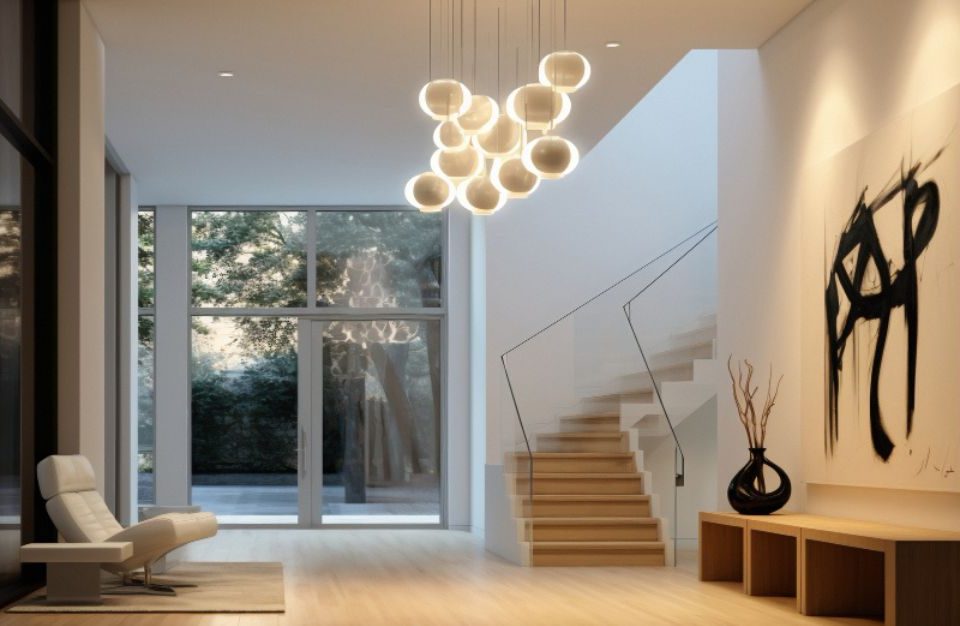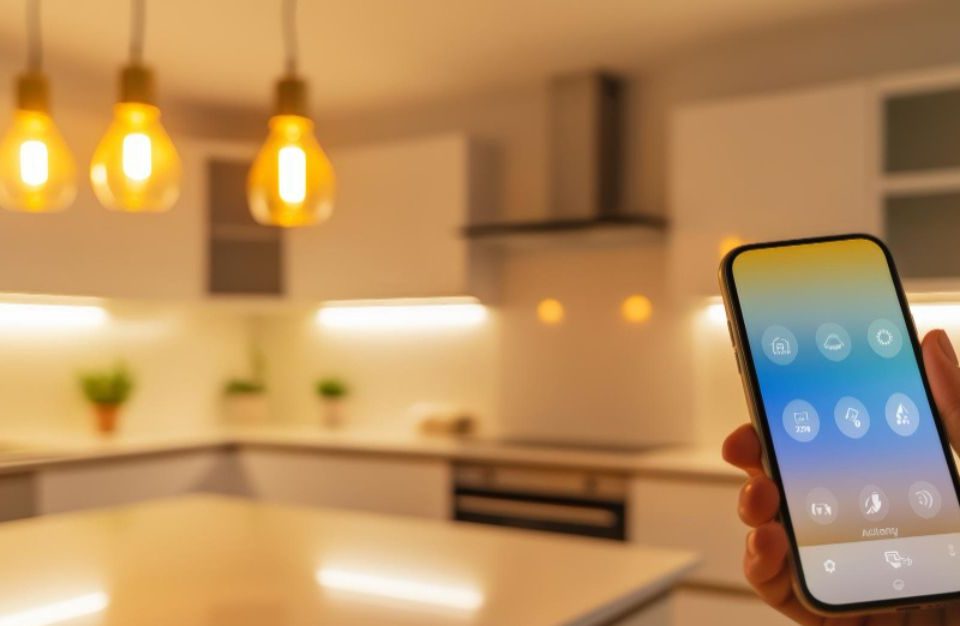
Practical Tips for Using Different Types of Outdoor Lighting at Home
June 18, 2025
Top Residential Lighting Mistakes—and How Our Consultants Avoid Them
June 18, 2025Lighting influences how a home feels, functions, and flows. A well-designed system can enhance comfort, highlight architectural features, and support everyday living.
Layered lighting designs are one of the approaches that offer structure and flexibility to suit different rooms and moods.
This guide uses practical tips and tailored product suggestions to explore how to apply it effectively.
Key Takeaways
- Layered lighting is a design approach that combines ambient, task, and accent lighting to improve comfort, functionality, and visual depth in a space.
- The three types of layered lighting are ambient for general brightness, task for focused activities, and accent to highlight features and create visual interest.
- To achieve layered lighting, start with a strong ambient base, add task lights for function, use accent lights for style, and optimise each layer based on the room’s purpose.
What is Layered Lighting and the Benefits of Light Layering

Layered lighting is a design technique that combines multiple types of lighting within a single space to create depth, balance, and flexibility.
Light layering benefits include tailored illumination for specific activities and an enhanced comfortable atmosphere throughout the home.
- Improved Visual Comfort: Reduces harsh shadows and glare by evenly distributing light.
- Better Functionality: Ensures each area is well-lit for its intended use, from reading to cooking.
- Enhanced Aesthetics: Adds depth and highlights architectural or decorative features.
- Mood Lighting Control: Supports different moods and occasions through adjustable lighting combinations.
- Energy Efficiency in Layered Lighting: Allows selective lighting use, helping to save energy when full brightness isn’t needed.
How to Use the 3 Layers of Lighting in Your Home Design

Effective layered lighting is built on three distinct light sources—each serving a unique purpose. They create a balanced lighting scheme that supports aesthetics and everyday activities when used together.
1. Ambient Lighting
Also known as general lighting, ambient lighting provides the overall illumination that allows you to move comfortably and safely around a room. It’s typically the first layer installed in any space and sets the tone for the entire environment.
Common Fixtures: Ceiling-mounted lights, recessed lighting, large pendant lights, and wall-mounted fittings.
2. Task Lighting
This type of lighting is focused and practical. It is designed to illuminate areas where specific activities take place, such as reading, cooking, grooming, or working.
Common Fixtures: Desk lamps, under-cabinet lights, pendant lights over kitchen islands, vanity lights, and adjustable spotlights.
3. Accent Lighting
Accent lighting adds dimension and visual interest to a room. It highlights key design elements such as artwork, textured walls, niches, or display shelves, drawing the eye and creating focal points.
Common Fixtures: Track lights, wall sconces, spotlights, LED strip lights, and picture lights.
Elevate your home lighting design by combining the three lighting elements—perfect for creating stunning condo lighting ideas or enhancing semi detached home design.
5 Layered Lighting Techniques to Light Your Home

Creating a well-layered lighting setup starts with understanding the purpose of each lighting type and how they work together.
The goal is to combine ambient, task, and accent lighting in a way that enhances comfort, functionality, and style across different areas of your home.
Below are practical strategies to help you build a layered lighting design tailored to each space.
1. Establish a Comfortable Ambient Base
Begin with a consistent, overall light source that fills the room without creating harsh shadows. This layer sets the foundation for other lighting elements to build upon.
Where to Apply It:
- Living Room & Dining Area: Use LED Downlights or flush-mount ceiling lights for balanced brightness.
- Bedrooms: Opt for soft pendant lights or cove lighting to create a calming atmosphere.
2. Add Focused Task Lighting for Functionality

Incorporate targeted lighting where activities such as reading, cooking, or working occur. This ensures clarity and comfort without overpowering the entire space.
Where to Apply It
- Kitchen: Use LED Strip Lights under cabinets to brighten countertops.
- Study Rooms & Home Offices: Desk lamps or wall-mounted spotlights work well for focused illumination.
3. Highlight Features with Accent Lighting
Accent lighting draws attention to architectural features, artwork, or textured surfaces, adding dimension and personality to your home.
Where to Apply It
- Living Room Feature Walls: Install track lights or spotlights such as Track Lighting Systems.
- Entryways & Hallways: Decorative sconces or pendant lights create a welcoming tone.
4. Use Dimmers and Smart Controls for Flexibility

Dimming systems allow you to adjust brightness levels based on time of day or activity, adding versatility and energy savings.
Where to Apply It
- Across Living Areas and Bedrooms: Integrate smart dimmers to fine-tune lighting ambiance from day to night.
Discover how a smart home lighting system can enhance comfort, security, and energy efficiency—explore features that adapt to your lifestyle.
5. Balancing Natural and Artificial Light
Complementing natural daylight with well-placed artificial lighting reduces glare and keeps spaces visually balanced throughout the day.
Where to Apply It
- Home Offices & Living Rooms: Place lights near windows and use sheer curtains to diffuse daylight. Floor lamps offer an ideal supplement in the evening.
- Dining Areas: Mix natural light with soft pendant or chandelier lighting for a seamless transition from day to night.
Learn how to layer different types of outdoor lighting effectively and avoid common lighting mistakes that can impact your home’s look and safety.
Book a Lighting Consultation to Build a Professional Layered Lighting Plan

A successful layered lighting design begins with careful planning, ensuring each light serves a clear purpose while contributing to your home’s overall look and feel.
Mr Bright Lighting, a trusted LED lighting supplier in Malaysia, offers expert consultation services to help you create a personalised lighting layout that enhances comfort, function, and style.
- Personalised Lighting Layouts: Our lighting design consultants assess each room’s natural light, purpose, and dimensions to propose optimal lighting combinations.
- Product Recommendations: Our team suggests high-quality lighting products from our catalogue of home interior lighting in Malaysia—including LED downlights, strip lights, track systems, and smart dimmers.
- On-Site or Virtual Consultations: We offer flexibility to suit your project timeline and location.
- Focus on Energy Efficiency and Mood Control: Our solutions balance practicality and ambience while maximising energy savings.
Ready to elevate your space? Learn more about how Mr Bright Lighting provides tailored solutions through lighting design consultation.
Conclusion
Layered lighting is a practical and impactful approach to home design. Combining ambient, task, and accent lighting allows you to transform each room into a space that supports daily activities while elevating the overall aesthetic.
A thoughtful lighting plan enhances any space—be it a compact condo, a family home, or a semi-detached layout—by adding clarity, comfort, and visual harmony.
For tailored advice and quality lighting solutions, contact Mr Bright Lighting and discover how a layered lighting design can bring your home to life.





